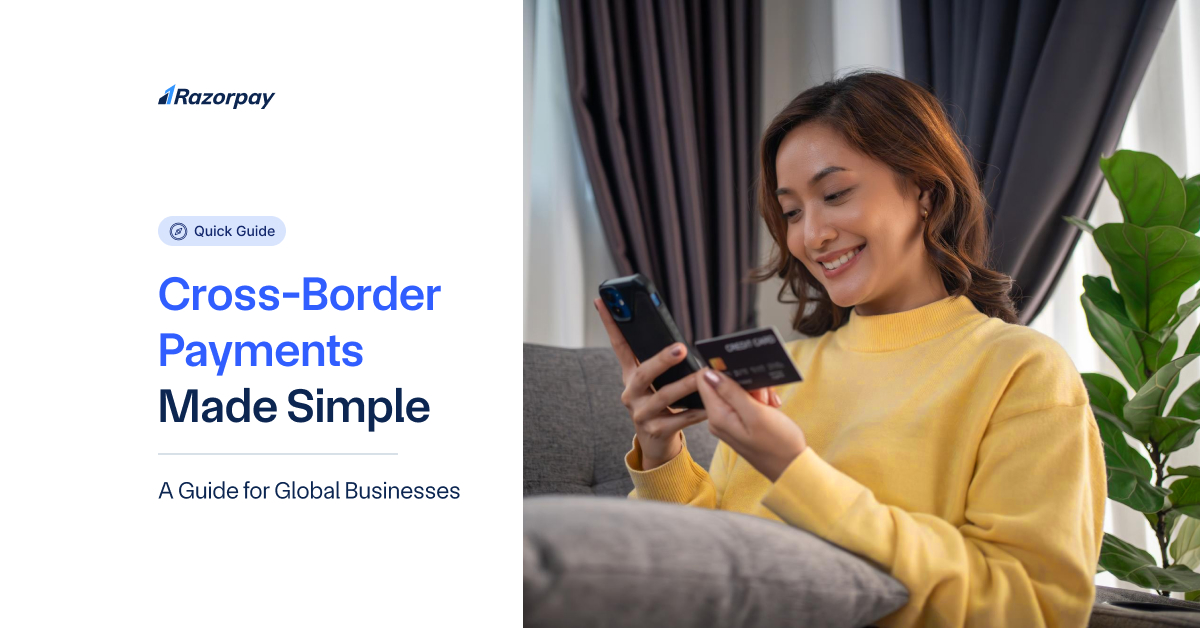Cross-Border Payment: What is it & How it Works in Singapore
With a robust financial infrastructure, advanced regulatory frameworks, and a strategic location, Singapore is a global economic hub that continues strengthening its leadership in cross-border payments. The country’s cross-border payment solutions include traditional bank transfers, digital wallets, and emerging blockchain-based systems, ensuring secure and fast transactions. To navigate this evolving landscape, businesses need to leverage the right cross-border payment platform for smooth B2B cross-border payments and international transactions.
In this blog, we’ll dive into how cross-border payments work in Singapore, their benefits, challenges, and best practices to ensure seamless financial flows.
What are Cross-Border Payments?
Cross-border payments are transactions where the sender and recipient are in different countries. These payments enable businesses, financial institutions, and individuals to transfer money internationally, whether for trade, investment, or personal remittances. They involve different currencies, exchange rates, and financial networks, requiring banks and payment providers to facilitate secure and efficient transfers.
Why Use Cross-Border Payments?
In today’s interconnected world, cross-border payments are essential for global trade, e-commerce, outsourcing, and remittances. Businesses rely on them to pay international suppliers, expand into new markets, and operate seamlessly across borders. Likewise, individuals use them to send money to family abroad or make purchases from global retailers.
With efficient cross-border payment solutions, businesses and individuals can transact in different currencies with ease. These payments offer convenience, speed, and security, helping companies scale internationally while ensuring smooth financial flows across countries.
Types of Cross-Border Payment in Singapore
Singapore offers a variety of cross-border payment solutions, making it easier for businesses and individuals to transfer money internationally. The right method depends on factors like speed, cost, and security. Here are the key options:
1. Bank Wire Transfers
One of the most traditional ways to send money across borders, bank wire transfers use the SWIFT network to move funds securely between financial institutions. While reliable, they can be slow and expensive due to intermediary bank fees and processing times. This method is best suited for B2B cross-border payments and large transactions.
2. Credit/Debit Card Payments
Many businesses and individuals rely on credit and debit cards for international transactions. They are widely accepted, making them a convenient option for global e-commerce and travel. However, foreign exchange fees and transaction charges can add to the cost, making them less ideal for frequent payments.
3. Digital Wallets
Services like PayPal, GrabPay, and Wise offer faster and often cheaper alternatives to traditional banking methods. Digital wallets are widely used for cross-border e-commerce, freelancer payments, and remittances.
- Quick transactions with lower fees compared to banks.
- Ideal for small businesses, freelancers, and online shoppers.
4. Fintech Solutions (Razorpay, FAST, Blockchain)
Singapore has embraced fintech innovations to enhance cross-border transactions.
- Razorpay & FAST: These local payment systems provide near-instant transfers within Singapore and selected international networks.
- Blockchain-based payments: Offer secure, low-cost, and fast transactions without intermediaries, making them an emerging choice for businesses.
How to Make Cross-Border Payments?
Making cross-border transactions involves several key steps to ensure smooth, secure, and cost-effective payments. Whether using bank transfers, digital wallets, or fintech platforms, understanding the process helps businesses and individuals avoid unnecessary delays or fees.
1. Choose the Right Payment Method
The first step is selecting a suitable cross-border payment solution based on factors like speed, cost, and convenience. Options include:
- Bank Transfers: Secure but can be slow and costly due to intermediary banks.
- Digital Wallets: Faster and often cheaper, ideal for small transactions.
- Fintech Platforms: Services like PayNow and blockchain solutions provide instant transfers at lower costs.
2. Verify Fees, Exchange Rates & Processing Times
Every cross-border transaction comes with fees and exchange rate differences. It’s essential to:
- Compare transaction costs across different platforms.
- Check for hidden charges, such as foreign exchange markups.
- Consider processing times—some methods take minutes, while others may take days.
3. Initiate the Payment
Once you’ve selected the payment method and verified costs, the next step is to provide the necessary details, such as:
| Required Information | Description |
| Recipient Details | Name, account number, and country |
| Payment Method | Bank, digital wallet, or fintech platform |
| Amount & Currency | Ensure correct conversion rates |
| Purpose of Payment | Some providers require transaction reasons |
4. Ensure Compliance with International Regulations
To avoid payment delays or rejections, businesses must comply with international financial regulations. This includes:
- KYC (Know Your Customer): Verifying sender and recipient details.
- AML (Anti-Money Laundering) Checks: Ensuring transactions are legitimate.
- Country-Specific Rules: Some nations have restrictions on certain payments.
5. Track & Confirm the Payment
After completing the transaction, tracking the status helps ensure timely processing. Most cross-border payment platforms provide tracking tools to monitor progress and receive confirmation upon successful transfers.
By following these steps, businesses and individuals can make cross-border transactions efficiently, reducing costs and ensuring compliance with financial regulations.
How do Cross-Border Payments and Transactions Work in Singapore?
The cross-border payment process flow in Singapore is designed to ensure smooth, secure, and efficient international transactions. Whether businesses or individuals are sending money abroad, transactions go through multiple steps involving financial institutions, exchange rate conversions, and regulatory compliance.
1. Initiating the Payment
Cross-border payments start when a business or individual in Singapore transfers money to a recipient in another country. This can be done through:
- Banks – Traditional but often slower due to intermediary banks.
- Fintech Platforms – Faster and cost-effective alternatives like PayNow and blockchain-based solutions.
- Remittance Services – Used mainly for personal money transfers.
2. Processing & Currency Conversion
Once initiated, payments are processed through secure networks such as SWIFT, local clearing systems, or fintech infrastructures such as payment gateways. Key aspects include:
- Exchange Rate Conversion – Payments are converted into the recipient’s local currency, with rates varying across providers.
- Transaction Fees – Charges depend on the payment method and financial institutions involved.
3. Regulatory Compliance & Security
To prevent fraud and ensure transparency, transactions must comply with:
- Monetary Authority of Singapore (MAS) regulations
- Anti-Money Laundering (AML) and Know Your Customer (KYC) requirements
- Sanctions and country-specific restrictions
4. Settlement & Final Credit
After clearing compliance checks, the funds are credited to the recipient’s account. Settlement times vary depending on the payment method—instant for digital wallets and fintech platforms, while banks may take 2–5 business days.
With Singapore’s push for digitization, cross-border transactions are becoming faster and more cost-effective, helping businesses expand globally while ensuring secure and seamless international payments.
Benefits of Cross-Border Payments
Cross-border payments are essential for businesses and consumers looking to operate beyond local markets. They enable seamless international transactions, opening new opportunities for growth and financial efficiency.
Key Benefits:
- Global Business Expansion – Businesses can reach international customers, suppliers, and partners, increasing revenue potential.
- Access to International Markets – Consumers gain access to global products and services, driving cross-border commerce.
- Faster & More Secure Transactions – Fintech solutions streamline payments, reducing delays and security risks compared to traditional banking methods.
- Cost-Effective Transfers – Digital wallets and fintech platforms offer lower fees and better exchange rates than conventional banks.
Disadvantages of Cross-Border Payment
While cross-border payments enable global transactions, they also come with challenges that can make them costly and complex for businesses and consumers.
Key Challenges:
- High Transaction Fees – Banks and payment providers charge fees for processing international payments, increasing costs.
- Longer Processing Times – Traditional methods, especially bank transfers, can take several days due to intermediaries.
- Currency Exchange Fluctuations – Unstable exchange rates can impact the final amount received by the recipient.
- Regulatory Compliance – Different countries have strict financial regulations, causing delays and additional paperwork.
- Fraud & Security Risks – Cross-border transactions are vulnerable to fraud, making secure payment solutions essential.
To overcome these challenges, businesses should choose reliable cross-border payment solutions that offer speed, security, and cost efficiency.
How Fintech Companies in Singapore are Simplifying Cross-Border Payment?
By leveraging cutting-edge technology, Fintech companies in Singapore eliminate traditional barriers with key innovations such as:
- Real-Time Transactions – Instant payments reduce waiting times compared to traditional bank transfers.
- Lower Transfer Fees – Fintech platforms offer competitive pricing, cutting down costs for businesses and consumers.
- Seamless Currency Conversion – Automated forex solutions ensure better exchange rates and smoother transactions.
- Blockchain-Based Payments – Increased security and transparency reduce fraud risks.
- Regulatory Compliance Support – Built-in compliance tools help businesses navigate international financial regulations.
How Does Razorpay Enable Seamless Cross-Border Payment?
Razorpay simplifies cross-border payments by offering secure, fast, and cost-effective solutions tailored for global businesses. With seamless integration, multi-currency support, and compliance with international regulations, Razorpay ensures smooth transactions across borders, helping businesses expand globally.
Key Features of Razorpay’s Cross-Border Payment Solutions:
- Multi-Currency Support – Accept payments in multiple currencies with real-time conversion.
- Global Payment Network Integration – Connects with international payment gateways for seamless transactions.
- Low Transaction Fees – Competitive pricing ensures cost-effective international transfers.
- Fast & Secure Processing – Advanced fraud prevention and compliance tools enhance security.
- Easy Integration – APIs and plugins simplify onboarding for businesses of all sizes.
With Razorpay, businesses can accept international payments effortlessly, ensuring a smooth experience for both merchants and customers while navigating the complexities of cross-border transactions with ease.
Conclusion
Singapore’s growing role in global trade and finance makes efficient cross-border payments essential for businesses and individuals. With increasing international transactions, seamless payment solutions ensure faster settlements, lower costs, and secure transfers. Whether expanding globally or managing overseas payments, choosing the right cross-border payments platform is key.
FAQs
Q.1 How long does a cross-border payment take?
The processing time for cross-border payments depends on the payment method, financial institutions involved, and currency exchange processes. Traditional bank transfers can take 2–5 business days, while digital wallets and fintech solutions often enable faster transactions, sometimes within minutes or hours. Factors like regulatory checks, time zones, and intermediary banks can impact the speed of cross-border transactions.
Q.2 What is the difference between cross-border payment and international payment?
Cross-border and international payments are often used interchangeably, but there’s a slight distinction. Cross-border payments involve transactions between parties in different countries, including B2B payments, remittances, and trade settlements. International payments generally refer to transactions processed via global banking networks, usually in different currencies.
Q.3 What is the risk of a cross-border transaction?
Cross-border transactions come with risks such as currency fluctuations, regulatory restrictions, fraud, and longer settlement times. High transaction fees and compliance challenges can also affect payment efficiency. Choosing a secure and regulated cross-border payments platform helps businesses mitigate these risks and ensure seamless international transactions.
Q.4 What could be the future of cross-border payments?
The future of cross-border payments is shifting toward faster, more transparent, and cost-effective solutions. Emerging technologies like blockchain, AI-driven fraud detection, and real-time payment networks are revolutionizing international transactions. As fintech companies innovate, expect seamless cross-border payments with lower costs, enhanced security, and near-instant processing times.




